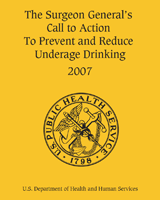NCBI Bookshelf. A service of the National Library of Medicine, National Institutes of Health.
Office of the Surgeon General (US); National Institute on Alcohol Abuse and Alcoholism (US); Substance Abuse and Mental Health Services Administration (US). The Surgeon General's Call to Action To Prevent and Reduce Underage Drinking. Rockville (MD): Office of the Surgeon General (US); 2007.
ALCOHOL ABUSE
(A) A maladaptive pattern of drinking, leading to clinically significant impairment or distress, as manifested by at least one of the following occurring within a 12-month period:
- Recurrent use of alcohol resulting in a failure to fulfill major role obligations at work, school, or home (e.g., repeated absences or poor work performance related to alcohol use; alcohol-related absences, suspensions, or expulsions from school; neglect of children or household)
- Recurrent alcohol use in situations in which it is physically hazardous (e.g., driving an automobile or operating a machine when impaired by alcohol use)
- Recurrent alcohol-related legal problems (e.g., arrests for alcohol-related disorderly conduct)
- Continued alcohol use despite having persistent or recurrent social or interpersonal problems caused or exacerbated by the effects of alcohol (e.g., arguments with spouse about consequences of intoxication).
(B) Never met criteria for alcohol dependence.
ALCOHOL DEPENDENCE
(A) A maladaptive pattern of drinking, leading to clinically significant impairment or distress, as manifested by three or more of the following occurring at any time in the same 12-month period:
- Need for markedly increased amounts of alcohol to achieve intoxication or desired effect; or markedly diminished effect with continued use of the same amount of alcohol
- The characteristic withdrawal syndrome for alcohol; or drinking (or using a closely related substance) to relieve or avoid withdrawal symptoms
- Drinking in larger amounts or over a longer period than intended.
- Persistent desire or one or more unsuccessful efforts to cut down or control drinking
- Important social, occupational, or recreational activities given up or reduced because of drinking
- A great deal of time spent in activities necessary to obtain, to use, or to recover from the effects of drinking
- Continued drinking despite knowledge of having a persistent or recurrent physical or psychological problem that is likely to be caused or exacerbated by drinking.
(B) No duration criterion separately specified, but several dependence criteria must occur repeatedly as specified by duration qualifiers associated with criteria (e.g., “persistent,” “continued”).
Source: Adapted from American Psychiatric Association (APA). Diagnostic and Statistical Manual of Mental Disorders, 4th Edition, Text Revision. Washington, DC: APA, 2000.
- Appendix B: DSM-IV-TR Diagnostic Criteria for Alcohol Abuse and Dependence - The...Appendix B: DSM-IV-TR Diagnostic Criteria for Alcohol Abuse and Dependence - The Surgeon General's Call to Action To Prevent and Reduce Underage Drinking
Your browsing activity is empty.
Activity recording is turned off.
See more...
